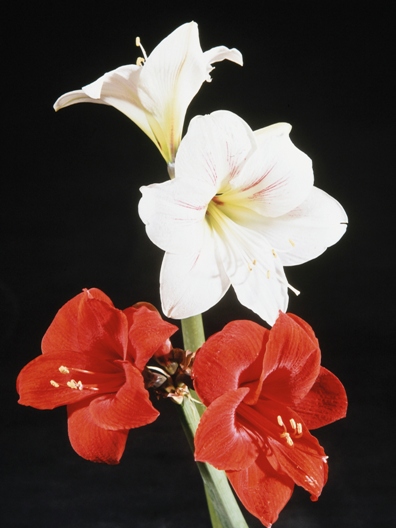
An Amaryllis is a wonderful flowering houseplant to give as a gift for Valentine’s Day; and with the proper care it will re-bloom year after year. Amaryllis bulbs, which usually flower from December until June, can be purchased as pre-planted bulbs ready to bloom or, you can buy the bulbs and do the planting yourself. The larger and fatter the bulbs, the more flowers the plant produces. The brightly colored flowers come in red, orange, white, pink, and salmon. This plant is considered poisonous, especially the bulb, so please keep it away from children and pets.
Amaryllis bulbs need bright indirect light while growing. Keep the soil slightly moist but never soggy and the temperature between 68-75 degrees. Once blooms appear increase the water slightly and move the plant to a cooler area, about 65 degrees is ideal. This helps the flowers last longer. Feed an Amaryllis monthly with a plant food high in potassium and phosphorous and low in nitrogen, diluting the food to ½ the recommended strength. Plant the bulbs from late fall to mid spring using a good commercial bulb soil and large fat bulbs. Be sure to soak the base & roots of the bulbs for a few hours and then plant them up to their necks in soil. Amaryllis like to be root bound so your container should be only one or two inches larger than the bulbs. It will take from 7-10 weeks for the first buds to appear.
Amaryllis may get various viral and fungal diseases that cause blotchy leaves. There is no good remedy for these infections, so isolate the plant to prevent the problem from spreading to your other plants. These diseases occur when plants are too close together or the leaves get wet. Provide good air circulation and keep the leaves of an Amaryllis dry.
After Bloom Care
Once the flowers die, immediately remove them from the stem. When the stem itself starts to droop, cut it back close to the top of the bulb. Place your Amaryllis in a bright location and water and fertilize as you normally would for the next 5-6 months. This should take you to the end of the summer. During these months you are encouraging leaf growth that helps the bulbs store energy for next years flower production. In the fall, as the leaves begin to yellow, prune the plant back to about 1”-3” from the bulb. Remove the bulbs from the pot, clean them, and place them in a cool (40-50 degrees) dark place so they can rest for about 6-8 weeks. If you place the bulbs in your refrigerator, keep them away from apples. Apples emit a gas that sterilizes Amaryllis bulbs. Allow the bulbs to rest at least six weeks then repot them about eight weeks before you’d like them to bloom again.
Frequently Asked Questions
1. I never get any flowers from my bulbs, only lots of green leaves.
There are several reasons: You may be using a fertilizer that is too high in nitrogen; the plant is not getting enough light and warmth; the soil is staying too wet; or you may be digging up the bulbs too early after the flowers fade.
2. There are red spots on the leaves, petals, and stems of my Amaryllis. They start out small but spread to several inches.
The spots are called Red Blotch. Cut back on watering, remove the diseased leaves and petals, and then spray with a commercial fungicide
3. My Amaryllis only produces one or two small flowers while my Mom’s gets five or six huge blooms. Why?
Your Mom probably started out with large plump expensive Amaryllis bulbs while you tried to save money buying the small inexpensive ones. The larger the bulbs the more flowers this plant produces. Be sure to continue to fertilize while only the green plant is growing and give it plenty of sun.
4. Do Amaryllis get bugs?
Amaryllis rarely attracts bugs when indoors. However, if you place this bulb plant outside, it may attract a few grasshoppers.
Judy Feldstein is the founder of Foliage Unlimited, one of the largest interior plant design, sales, & maintenance companies in Arizona. After selling the company, Judy developed an indoor plant care website Houseplant411.com.
Related Articles & Free Email Newsletter
Managing Scale, a Difficult Insect Pest on Houseplants



Comment here